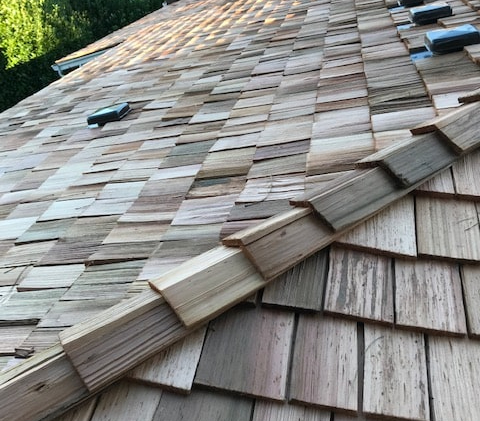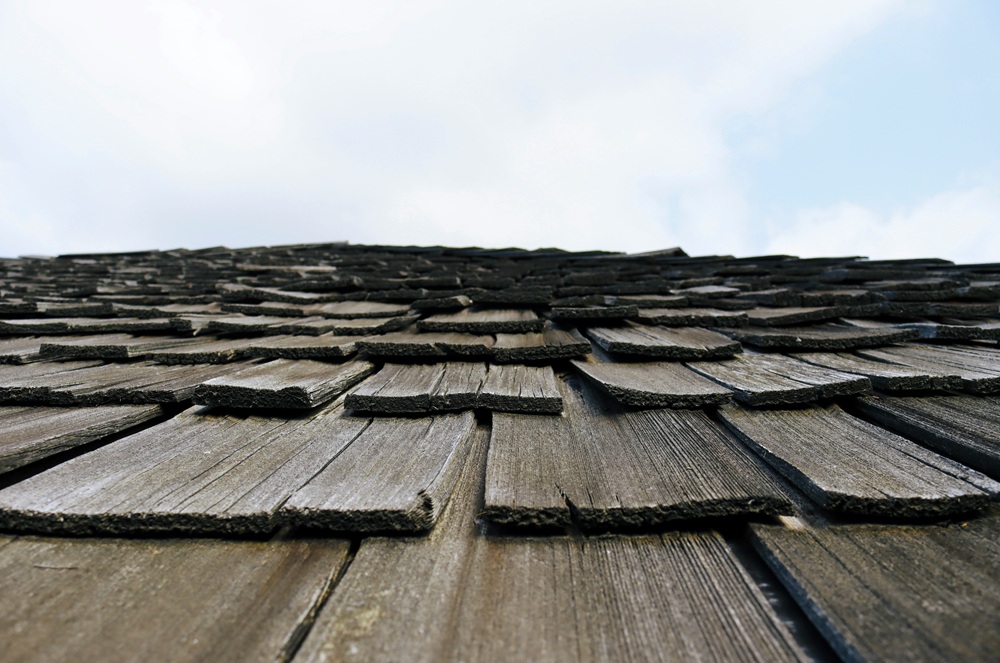
Updated on November 19, 2025
Cedar shake roofs have a classic, timeless look that many homeowners fall in love with. The warm tones, textured surface, and rustic character of wood shake shingles give a home undeniable charm. But as wildfire seasons become longer and more severe, that beauty comes with a growing concern: Are cedar shake roofs a fire hazard
Whether you’re thinking about installing cedar shakes or looking at a home that already has them, it’s important to understand the fire risks—and what options are available if safety is at the top of your list.
What Makes Cedar Shake So Popular?
There’s a reason cedar shake roofs have been used for generations. Cedar is a naturally durable wood, and when used as a roofing material, it creates a textured, layered look that’s hard to replicate. Real cedar shakes age beautifully over time, gradually turning a soft silver-gray that blends well with natural surroundings. It’s an appealing choice for anyone who values authentic materials and curb appeal.
In addition to aesthetics, cedar is relatively lightweight and offers some insulation benefits, which can help with energy efficiency in certain homes. But despite these benefits, the fact remains: it’s still wood.
Understanding the Fire Risk

Wood is a combustible material—and when it’s exposed to heat, wind, and dry conditions, it can become fuel for a fire. In the case of wood shake shingles, the individual pieces of cedar can dry out over time, making them even more flammable.
Homes in fire-prone areas are especially vulnerable. Blowing embers from nearby wildfires can land on a dry roof and ignite it quickly. For this reason, many local fire departments and building codes now discourage or even prohibit the use of untreated cedar shake as a roof covering in high-risk zones.
Even in urban or suburban neighborhoods, proximity to trees, wind-blown embers, and climate conditions can raise the risk of a fire starting on or spreading through a cedar roof.
What About Fire-Treated Cedar Shakes?
To address these concerns, some manufacturers offer fire-retardant-treated (FRT) cedar shakes. These products are pressure-treated with chemicals that reduce flammability and allow them to meet certain fire resistance standards.
This treatment can improve the fire performance of a cedar shake roof, especially when combined with a fire-resistant underlayment and proper attic ventilation. However, treatment doesn’t last forever. Over time, weather and UV exposure can degrade the protective layer, reducing its effectiveness unless maintained or reapplied according to manufacturer guidelines.
And even with treatment, many FRT wood shakes still fall short of the highest fire safety ratings required in extreme fire zones—such as Class A ratings often needed in the Western U.S. So while it’s safer than untreated wood, it may not provide complete peace of mind.
What About Insurance and Local Building Codes?
Homeowners in wildfire-prone areas may find that a wood shake roof affects their insurance coverage. Some insurance companies may increase premiums or decline coverage altogether for homes with combustible roofing materials. Others may require proof of fire treatment or inspection reports before providing a policy.
In addition, more municipalities and state agencies are updating their building codes to improve fire safety. In some parts of the Pacific Northwest and California, roof coverings made from untreated wood are no longer allowed on new construction or major remodels in wildfire zones.
If you’re buying a home with cedar shakes, it’s wise to check local ordinances and reach out to your insurance provider before making a decision.
Are Cedar Shake Roofs a Fire Hazard? Some Common FAQS
1. Are cedar shake roofs a fire hazard?
Yes, untreated cedar shake roofs are made from real wood, which is naturally flammable. In dry or windy conditions, especially in fire-prone areas, they can increase the risk of fire spreading.
2. Can cedar shakes be made fire resistant?
Some cedar shakes are treated with fire-retardant chemicals to reduce their flammability. While this helps, it doesn’t make them completely fireproof, and the treatment may wear down over time.
3. Will a cedar shake roof affect my home insurance?
In some cases, yes. Insurance companies may raise premiums or limit coverage if your home has a wood shake roof, especially in wildfire zones. Always check with your provider.
4. Are there roofing materials that look like cedar but are safer?
Yes. Composite shakes, fire-rated shingles, and even metal roofing can mimic the look of cedar while offering better fire resistance and longer lifespans.
5. Can Warner Roofing inspect my cedar shake roof?
Absolutely. We can assess the condition of your roof, discuss fire safety concerns, and recommend the best options—whether you want to keep the look or switch to something more fire resistant.
Whether you’re updating your current roof or evaluating the condition of an older one, our team can inspect your home, explain your options, and help you choose a solution that fits your style, budget, and location. We’ve been roofing homes in the Pacific Northwest for decades, and we’re committed to craftsmanship that not only looks great but lasts for years to come.
Cedar shake roofs are undeniably beautiful, but in today’s climate, fire resistance is more than just a nice-to-have—it’s a necessity. While fire-treated shakes offer some protection, they still carry risk and often don’t meet the highest fire safety standards.
If you’re concerned about living in a fire-prone area, it may be time to consider alternative roofing options that provide the same visual appeal with far greater protection. Warner Roofing can help you make an informed decision that keeps your home safe without sacrificing style.